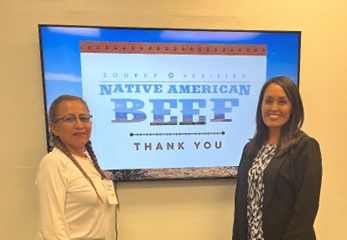Mentor Protégé CAMP Class 2, Profile 7: Kim Yazzie and Treva Henio
Author
Published
9/26/2023
The CAMP mentor/protégé series continues with this seventh profile for Class 2 with Apache County rancher Kim Yazzie and NRCS Supervisory Natural Resource Specialist, Treva Henio. They have already met, and both have exchanged insights and appreciation for the experiences as is evident by their comments below.
With the launch of the Conservation Agricultural Mentoring Program (CAMP) in Arizona, in partnership with the Arizona Farm Bureau, The NRCS team has been front and center in enthusiastically driving this unique mentoring partnership.
While several other states have the NRCS CAMP program, Arizona is unique in its partnership effort with the Arizona Farm Bureau.
The Yazzie Henio partnership, along with all the mentor protégé partnerships, works to understand Arizona agriculture and conservation opportunities, joining forces to provide firsthand experience of the conservation practices and agricultural happenings.

Kim Yazzie (right) invited Treva Henio to the first 2023 spring calf sale of 80-head with the Office of Navajo Hopi Indian Relocation-Padres Mesa Demonstration Ranch of Chambers, Arizona at the Livestock Hub Sale Barn in Navajo, Arizona, the birthplace of the Native American Beef program.
From the Mentor: Kim Yazzie
Talk about your first meeting. We first invited Treva to the first 2023 spring calf sale of 80-head with the Office of Navajo Hopi Indian Relocation-Padres Mesa Demonstration Ranch of Chambers, Arizona at the Livestock Hub Sale Barn in Navajo, Arizona. The initial birthplace of the Native American Beef Program by Labatt Food Service. We shared with her how the program originated here in Navajo and grew into the Native American Beef program. Today the program runs with five other neighboring tribes of the Navajo: Hopi, Laguna, Acoma, and Jemez. We shared with her the building blocks of the program, and the details on how important every rancher, customer, and person involved plays an important key role.
Share specifics about what you got out of it as the farmer/rancher. As a result of Treva's visit, I learned that the Natural Resources Conservation Service has a proud history of supporting America’s farmers, ranchers, and forest landowners. NRCS has helped people make investments in their operations and local communities to keep working lands working, boost rural economies, increase the competitiveness of American agriculture, and improve the quality of our air, water, soil, and habitat. This type of program can assist our Native American Beef producers who raise the utmost high-quality premium beef. NRCS can deliver conservation solutions so producers can protect natural resources and feed a growing and supporting social and economic good for those participating tribes.
For the remaining time with the program, what do you also hope to help with? Thank you for inviting me along on this project. My protégée was of great knowledge in sharing assistance and programs available for Ag producers. After learning about the details and concerns of NRCS, I hope to be of assistance to encourage producers to reach out to such programs to assist them along the way to improve their quality of investing in better ways for better days within their everyday operations.
From the Protégé: Treva Henio
What’s been the biggest takeaway from your first gathering? My biggest takeaway from my first meeting with Kim at the sale barn in Chamber, Arizona, was feeling proud loading up a calf crop onto a semi-truck headed to a feedlot; knowing the calves were raised locally on tribal land. I immediately wanted to absorb more about the Native American Beef program, as it initially began with Navajo producers inspired me more, and ten years later several Pueblo and Apache Tribes across Arizona and New Mexico established resilient partnerships. All the ranchers practice good stewardship of the land to produce quality grass-fed beef and onto marketing to Labatt Food Services. However, there are challenges: the program has ranchers faced with the ongoing drought, demand for quality water, abundant forage production, and engaging potential producers to have control of the land to expand the program.
Why have you felt this program has been helpful? I feel like this program gave me more respect and understanding of the demand for our NRCS programs to be promoted through outreach; to provide a thorough background on various funding programs that may be suitable for the rancher’s operation. Their program has qualified personnel to provide quality animal husbandry to fulfill the well-being of their finished product, and our agency has certified master planners to engage on behalf of conserving natural resources on tribal lands in addressing resource concerns.
What more do you hope to learn? I hope to learn more about the Native American Beef, especially their marketing system. With this assignment not only did I experience the sale portion of it, but I was also fortunate to receive a one-on-one presentation and a tour of the packaging facility at Labatt Food Services. My in-person experiences inspired me to share our agency funding programs with their producers, as the majority of their customers are schools, casinos, steakhouses, and local markets, all important to our local economy. Our agency programs are available to help people, help the land.